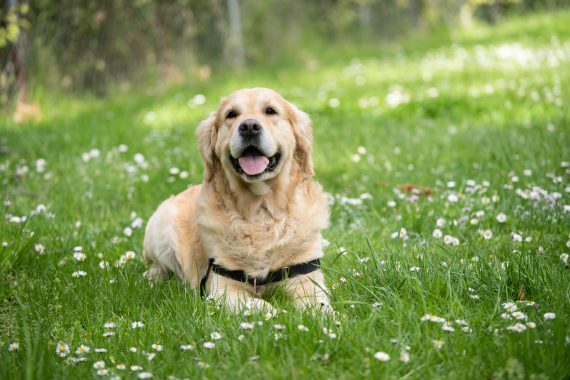How to Create A Dog Friendly Garden

Dogs are extremely social animals and love to play outside. They make the perfect companion for when you are relaxing outside in your garden. However, some keen gardeners may be worried that letting their dogs run around outside can end up causing damage to their garden or even worse, being dangerous for their dog. Here we discuss how to create a dog-friendly garden so that you and your furry friend can enjoy the long spring and summer days together with the peace of mind that your garden will remain in great condition and your dog will remain healthy.
Check what plants are toxic to dogs
The key thing to start with is to ensure your dog remains safe in your garden at all times. A vital part of this is having an understanding on which plants and flowers are toxic to your dog and therefore should not be in your garden. If you do have plants that are potentially toxic to dogs, ensure they remain out of reach at all times.
Here is a shortlist of plants that can be toxic to dogs: aloe vera, lilies, daffodils, tulips, cyclamen, chrysanthemum, ivy, alliums, magnolia bush, snapdragons, petunias, gladiola, iris, primrose, sweet-pea, geranium and foxglove. This is not an exhaustive list so always check in advance.
Be careful when planting your flowers from bulbs as the bulb of the plant can have worse effects than the flower.
The effects
The effects from ingestion can range from vomiting and diarrhoea to more extreme reactions such as depression, anorexia, changes in urine colour, seizures and can even be fatal. It is, therefore, best for these plants to be avoided. If your dog has any of these symptoms or you notice any rashes, unexplained pain, a swollen mouth or breathing issues, then go to the vet for a checkup and advice.
Also, be careful when choosing plants that are thorny as these can end up hurting the dog. Not only could they puncture the skin, but they can also cause more severe internal damage if they are eaten.
It is not just decorative plants that you need to be careful of. If you have a vegetable patch, herb garden or greenhouse, be aware that dogs can react badly to the following foods: tomato, onions, grapes, rhubarb, apple tree, cherry tree and garlic.
Designate areas for the dog
Although dogs, especially puppies, can get overexcited when outside or in social situations, you can train them to reduce the amount of mischief they cause.
Create areas of your garden that are designated to your dog. In these areas, ensure they have a place to sit and give them treats and toys so that the dog associates this area as theirs. Providing a digging spot here will also encourage them to only dig here and not other areas of your garden. Create clear boundaries using stones to protect your flower borders. Alternatively, consider having raised flower beds to help protect your flowers from the dog but also to create a great design for your garden.
Having a designated toilet area for your dog is also important. If you let your dog wee anywhere, you can end up with scorched brown patches of grass. Initially, whenever your dog uses the designated toilet space, reward them accordingly to reinforce the behaviour.
Be careful with pesticides and fertilisers
Try avoiding these all together but if that is not possible, then try to use organic options as they will be safer for dogs to be around. There are also plenty of ways to eliminate garden pests whilst still providing a safe environment for your dog, so always read labels before buying any product as they should state if they are pet-friendly.
Also, be careful if you have a pond or water feature. Do not add any additives as dogs will inevitably head to this when they want a drink.
Keep your dog away from slugs and snails
Your dog may be intrigued by slugs and snails in your garden however lungworm can be contracted when a dog eats an infected slug or snail. Also, ensure you use organic slug pellets to keep them at bay. If you think your dog has eaten one and shows a difficulty in breathing, coughing, lethargy or bleeding then always ensure you get them seen by a vet.
Plant robust plants
Choosing robust plants over fragile and delicate will always be beneficial as dogs inevitably want to run around and you don’t want your flower beds completely flattened. Bushes, shrubs such as lavender and other hardy plants are great choices.
This does not mean that you cannot have any delicate flowers, just plant these more fragile plants in the centre of your displays and use the more robust plants as an additional form of protection.
Provide shade and shelter
A dog-friendly garden can not be achieved without ensuring your pet always has somewhere shady to go when it is sunny. It is extremely easy for a dog to overheat so having regular shade and water is vital.
Ensure your garden is secure
Check that areas like swimming pools and sheds remain off-limits. Use fences and locked gates to ensure the dog remains safely in the garden and cannot escape. Also, ensure your compost bin is secure so your dog cannot rummage in it.
Dogs can also jump deceptively high so ensure you have a garden that is fenced by at least six-foot-high fences to ensure they cannot jump over them and escape.
What next?
By following these simple tips, you can create a safe haven that your family and your dog can enjoy. It is possible to keep a neat and full garden whilst still allowing your dog to enjoy it as well. From creating dog-specific zones to providing shelter and avoiding toxic plants, your garden can be a communal area that everyone can enjoy.